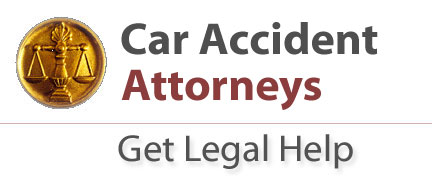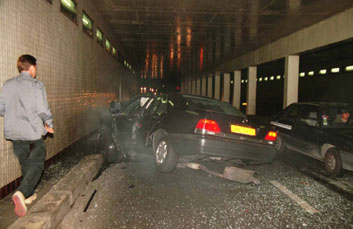
|
Car-Accidents.com Home Page Main Picture Gallery Make Model Page California Car Crash Attorneys |
 Find Auto Accident Lawyers: Click Here Find Auto Accident Lawyers: Click Here |
California Car Crash Law Info Damages for Car Accidents under California Law Generally, an individual injured in an California automobile accident may bring a claim or lawsuit to recover the following: Actual Damages (Expenses associated with property damage and
medical costs), California's Insurance Coverage Law Threshold for Liability An individual who brings a claim or lawsuit against another driver for injuries sustained in an automobile accident, also known as a "claimant" or "plaintiff", must prove that the other driver was negligent. Simply put, it must be proven that the other driver failed to use that degree of care in operating his or her vehicle which would be required of a reasonably prudent driver under similar circumstances. Whitford v Pacific Gas & Elec. Co., 289 P2d 278, 136 Cal.App.2d 697 (1955). Also, it must be proven that the other driver's negligence was the cause of the plaintiff's damages and injuries. Clarke v Hoek, 174 C.A.3d 208 (1985); Peter W. v San Francisco Unified School District, 60 C.A.3d 814 (1976). The cause which must be proven, "proximate cause" or "legal cause", requires the claimant/plaintiff to demonstrate (1) the defendant's negligence contributed to the plaintiff's injury. Sagadin v Ripper, 175 C.A.3d 1141, 221 C.R. 675 (1985), Gordon v Havasu Palms, 93 C.A.4th 244, 112 C.R.2d 816 (2001); and (2) there is no foreseeable, independent intervening act causing the plaintiff's injury. Mitchell v Gonzales, 54 C.3d 1041, 1 C.R.2d 913, 819 P.2d 872 (Negligence must be substantial factor in causing injuries) Comparative Negligence Comparative negligence is negligence on the part of the plaintiff that contributes to his or her injury. California has adopted a "pure form" system of comparative negligence. Accordingly, if a plaintiff is even slightly at fault in creating the injury, damages will be reduced in proportion to his or her fault. Li v Yellow Cab Co., 13 C.3d 804, 119 C.R. 858, 532 P.2d 1226 (1975).
|
| Common Driving Actions Held To Be Negligent Under California Driving Law The list below is by no means inclusive of all types of actions deemed negligent, but rather is representative of matters frequently encountered. Keep in mind that a jury determines whether a driver has acted negligently and whether the negligent act proximately caused the plaintiff's injury. Driving At Excessive Speeds Driving in excess of the lawful speed limit is negligent. (Veh.C. 22350, et seq).; Hardin v San Jose City Lines, 41 C.2d 432, 260 P.2d 63 (1953).Circumstances may make travel at speed less than maximum rate negligent. Scott v Texaco, Inc., 48 Cal.Rptr.785, 239 Cal.App.2d 431 (1966). Road signs which create a special speed zone is a factor in considering whether a driver acted negligently. Wilding v Norton, 319 P.2d 440, 156 Cal.App.2d 374 (1957). Failure To Keep A Proper Lookout A driver must keep a proper lookout for other persons or vehicles on the road and must keep his or her vehicle under such control so as to be able to avoid a collision. Leeper v Nelson, 293 P.2d 111, 139 Cal.App.2d 65 (1956); Lutz v Schendel, 345 P.2d 488, 175 Cal.App.2d 140 (1959). Failure To Yield Right Of Way - (Veh.C. 21800, et seq.) Intersections (Veh.C. 21800(a)-(e), Saterlee v Orange Glenn School Dist. 29 C.2d 581, 177 P.2d 279 (1947); Left turns (Veh.C. 21801) Sesler v Ghumman, 219 C.A.3d 218, 268 C.R. 70 (1990); Yield Right Of Way Signs (Veh.C.21803); U-Turns (VehC. 22105) Defects In Vehicles The owner or operator of a motor vehicle is under a duty to properly maintain his or her vehicle and to reasonably inspect the vehicle for defects in order to prevent an increase in the chances of inflicting injuries on others by its use. Yamaha Motor Corp. v Paseman, 268 Cal.Rptr. 514, 219 Cal.App. 958 (1990); Dyer v Superior Court, 65 Cal.Rptr.2d 85, 56 Cal.App.4th 61 (1997). Reckless Acts Or Willful Conduct An operator of a motor vehicle has engaged in willful misconduct when he or she has done something, or fails to do something, with the knowledge that injury to another will be the probable result. Ingram v Bob Jaffe Co., 239 P.2d 132, 139 Cal.App2d 193 (1956) Driving On The Wrong Side Of Road (Veh.C. 21650); Altomare v Hunt, 101 C.A.2d 10, 224 P.2d 904 (1950). Turning From The Wrong Lane (Veh.C. 22107) Failure To Use And/Or Maintain Brakes - (Veh.C. 26450, et seq.) Maloney v Rath, 69 C.2d 442, 71 C.R. 897, 445 P.2d 513 (1968). Failure to Use And/Or Maintain Headlights - (Veh.C. 24400, et seq.) Matlock v Farmers Mercantile Co., 258 C.A.2d 362, 65 C.R. 723 (1968). Failure To Give Proper Signals - (Veh.C. 22107-22111) Pittman v Boiven, 249 C.A.2d 207, 57 C.R. 319 (1967). Failure To Maintain A Safe Distance From Other Vehicles- (Veh.C. 21703) Pittman v Boiven, 249 C.A.2d 207, 57 C.R. 319 (1967). Driving Under The Influence Of Liquor Or Drug (C.C. 3333.4(a)(1)) |
 |